The Truth and Reconciliation Commission of Canada, a commission designed to address the allegations of abuse of First Nations children within residential schools, concluded in December 2015 that the implementation of these schools was an act of cultural genocide on the part of the Canadian government. Less than a year after, the University of Waterloo hosted the Integrating Knowledges Summit, a three-day conference aiming to acknowledge the racial discrimination that Indigenous people have faced and continue to face, as well as decide how to move towards progress.
The summit was introduced with a keynote address from Dr. Cindy Blackstock, executive director of the First Nations Child and Family Caring Society of Canada. Blackstock presented a history of residential schools from two distinct narratives. The first was from the perspective of the children affected, describing the difficult environment residential school students experienced, where they were malnourished, physically, emotionally, and even sexually abused, and had their culture erased. Blackstock shared stories like that of Chanie Wenjack, a First Nations child who died trying to walk back to his reserve in the middle of winter, hoping to escape his life at a residential school.
Many of the residential school students were forced from their homes through policies of child welfare. Having worked in child welfare herself, Blackstock expressed her feeling that indigenous children are unduly overrepresented in the Canadian child welfare system. A report from Statistics Canada found that in 2011, First Nations children made up 48.1 per cent of the 30,000 children in foster care, despite First Nations representing only 4.3 per cent of Canada’s population.
“I am not a utopian thinker. I think some of our kids need to be in foster care. But not at these rates,” Blackstock said.
The other perspective Blackstock presented was from the side of the government, composed of people who recognized the wrongs being committed towards residential school students, but who were indifferent to their suffering. One such person was Duncan Campbell Scott, former head of the Department of Indian Affairs. Scott oversaw the conduct of residential schools and upheld the abuse that occurred within them. Blackstock said that Scott’s legacy illustrates “how good people could do terrible things.”
From the other side of the matter, Blackstock told the story of Peter Henderson Bryce, Canada’s first health officer, who was hired by the Department of Indian Affairs to investigate health concerns within residential schools. Bryce found that the death rate from communicable diseases in residential school students was around 25 per cent, far higher than in any other schools at the time, and recommended simple suggestions such as improving ventilation, separating sick students from the healthy ones, and improving the student’s nutritional intake in order to reduce the spread of the disease. In total, the cost of implementing Bryce’s suggestions were around $15,000. The government refused on the grounds of it being too expensive, and so the deaths continued.
Bryce spoke out against the government’s decision and found himself persecuted, having research funding cut and eventually being pushed out of the public service.
“Here we have two men of the period, both non-Aboriginal, both going to the same church, both federal bureaucrats, faced with the dying of children. One conforms and says ‘we can’t save the money.’ He gets rewarded for this; he’s celebrated in Canadian culture. The other stands up for the kids, he’s punished, persecuted … There are rewards for doing the wrong thing in our society,” Blackstock said.
Blackstock also addressed the current manifestations of systemic racism, which can be seen in the division of government funding. Referring to statistics on how government resources are used, Blackstock said, “Across the board, First Nations people are getting less. Less water, less housing … less money for First Nations education, less money for First Nations child welfare.”
The claims of racial discrimination towards indigenous peoples were recognized by the judicial system January 2016, when the Canadian Human Rights Tribunal found that the Canadian government was racially discriminating in their child welfare programs for First Nations children, a policy which affects about 163,000 First Nations children and their families.
“The narrative [of ‘Indian savagery’] is so strong that it blinds us. It blinds us and allows these inequalities to play out in everyday society,” Blackstock said.
Blackstock said that she thought progress was being made in Aboriginal rights, but that structural discrimination is still a matter that is difficult to resolve.
“Governments don’t create change, they respond to change…. I’ve seen a lot of sincere prime ministers and politicians over the ages. But the discrimination continues to be perpetrated,” Blackstock said. “If [First Nations children’s] childhoods are not getting better, if their childhoods are not being treated equally, then people like you need to keep talking, and don’t stop, even if you feel like no one’s listening, because eventually someone will.”































